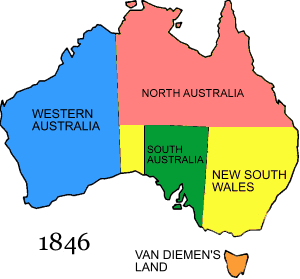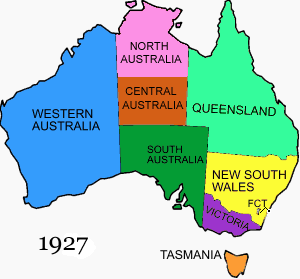Colony (1846–1847)

A colony of North Australia was briefly authorised by the British government by letters patent of 17 February 1846 but never established. The colony was to comprise that part of the Colony of New South Wales that is now the Northern Territory of Australia and that is now that part of the state of Queensland lying north of the 26th parallel. The colony was intended as a new penal colony after the end of transportation to the existing Australian colonies. [1] Since 1822, when John Bigge recommended the establishment of a convict settlement at Port Curtis (now the location of Gladstone, Queensland), the idea had been revived several times. As some difficulty was being experienced in finding work for time-expired convicts in Van Diemen's Land (Tasmania), it was decided to try the experiment of sending them to a new area and giving them land and a certain amount of government help. Edward Smith-Stanley, 14th Earl of Derby and William Ewart Gladstone, successive secretaries of state for the colonies, fathered the project. [2] Charles Augustus FitzRoy, the Governor of New South Wales, was to be the Governor and, in May 1846, Colonel George Barney was appointed to be Lieutenant-Governor and Superintendent. Gladstone selected Barney as a man used to authority and with previous experience in Australia. Barney was dispatched and arrived in Sydney on 15 September 1846 on the William Hyde. He quickly surveyed the coast in a small steamer, decided that Port Curtis was the most suitable place for a settlement and returned to Sydney. However, after a change of government ministries in Britain, Henry Grey, 3rd Earl Grey succeeded Gladstone, and he promptly vetoed the whole project and the letters patent authorising the colony were revoked in December 1846. [2]
Report of the revocation did not reach Australia and Barney until 15 April 1847. On 8 January 1847, Barney, his family, various officials and 87 soldiers and convicts sailed on the chartered barque Lord Auckland . The ship arrived off the southern entrance of Port Curtis and ran aground on shoals off the southern tip of Facing Island. On 30 January 1847, the (already revoked) colony of North Australia was proclaimed at Settlement Point on Facing Island and Barney was sworn in as Lieutenant Governor. The settlers spent seven weeks on Facing Island before being rescued by the supply ship Thomas Lowry and delivered to the intended site of settlement, the region now known as Barney Point. [3] There was much discomfort from the extreme summer heat. News of the revocation of the colony reached Barney and the party returned to Sydney. [2] The convict settlement lasted barely two months and cost the British government £15,000. [4]
The colony's intended role as a convict penal settlement attracted much criticism in the New South Wales Legislative Council. [5] [6]

